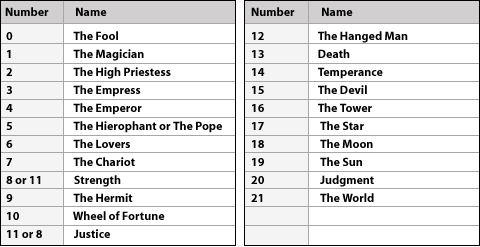The tarot (also known as tarocchi) is typically a set of seventy-eight cards, comprised of twenty-one trump cards, one Fool, and four suits of fourteen cards each—ten pip and four face cards (one more face card per suit than in Anglo-American playing cards).
The origins of tarot cards are obscure; cards approximating their present form first appeared in Italy and France in the late 14th century.
These cards are used throughout much of Europe to play Tarot card games such as Italian Tarocchini and French Tarot. In English-speaking countries, where the games are largely unknown, Tarot cards are utilized primarily for divinatory purposes, with the trump cards plus the Fool card making up the twenty-two major arcana cards and the pip and four face cards the fifty-six minor arcana.

For a detailed description of each of the names in the graph above, view Wikipedia.
There are many different tarot decks used in cartomancy. The meanings of the figures and numbers on tarot cards vary greatly among tarot readers and advocates, many of whom find connections between tarot and cabala, astrology, I Ching, ancient Egypt, and various other occult and mystical notions.
Tarot reading revolves around the belief that the cards can be used to gain insight into the current and possible future situations of the subject. Some believe they are guided by a spiritual force, while others believe the cards help them tap into a collective unconscious or their own creative, brainstorming subconscious.
The standard method for ‘reading’ the cards involves the use of a ‘spread,’ which means the card or cards chosen from the deck are placed in a certain position that has a designated meaning and interpreted from there. Methods of choosing the cards vary widely from reader to reader. Some allow the querent full range to shuffle and choose the cards and place them where they please, relying heavily on the random aspect of chaos to reveal the issue at hand. Some never allow anyone to touch their cards, and insist on placing the cards in a certain design in specific ways, feeling more comfortable in a highly structured reading environment. Readings can fall anywhere between the two extremes depending on the card reader.
References:
Wikipedia – Major Arcana










